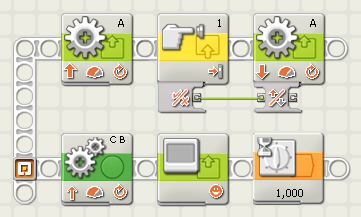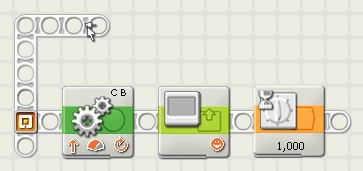The sequence beam controls the flow of your program. It indicates the sequence in which programming blocks will run. Blocks connected to the sequence beam can be downloaded to the NXT. Other blocks in the work area that are not connected to the sequence beam will not be downloaded.

You can use the starting point to create additional sequence beams that will allow your program to run simultaneous tasks. For example, you might have the main sequence beam in your program controlling a robot’s forward motion but have a second sequence beam controlling a robotic arm that sits on top of the robot.

Create a parallel sequence beam by moving the mouse pointer over the starting point (or over the wire stub), and pressing and holding your mouse button while you move the mouse upwards or downwards. This will draw out a sequence beam that can be connected to programming blocks. When you download and run the program, the blocks on both sequence beams will run in parallel. You can use data wires to have the blocks on both sequence beams communicate with each other.

You can also start a new sequence beam later in your program (i.e., not from the starting point). Do this by holding down the Shift key and moving your mouse pointer straight up or down from a position on the main sequence beam.
